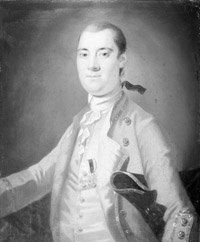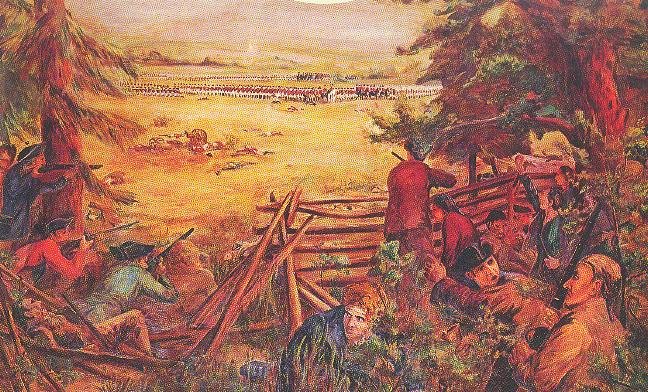On This Day in History -
May 16, 1771
The Battle of Alamance brings the War of the Regulation to a close
On this day in history, May 16, 1771, the Battle of Alamance brings the War of the Regulation to a close when North Carolina "Regulators" are defeated by Governor William Tryon. The War of the Regulation is often viewed as a pre-cursor to the American Revolution because it pitted regular settlers against corrupt colonial officials.
The War of the Regulation was the result of a severe drought and the heavy influx of new settlers into the inland parts of North Carolina during the early 1760s. The population grew quickly, bringing not only farmers, but also businessmen to the county seats. Farmers went into debt during the drought and the local population became dependent on merchants' supplies from the east. As debt increased, many fell into trouble and were brought to court by the merchants. A small cabal of merchants, lawyers, judges and sheriffs arose around each county courthouse that took advantage of the indebted population, often enriching themselves at the people's expense.
 Governor William Tryon
Governor William TryonThis led to the rising of the "Regulators" who attempted to reign in these corrupt officials, by force if necessary, when reason failed to prevail. The late 1760s saw many acts of violence against local officials, including an incident when the Regulators interrupted the North Carolina Assembly meeting in Hillsborough. Public buildings, shops and private residences were destroyed and some officials were severely beaten. Much of the population was sympathetic to the Regulators views, but did not support the use of violence.
By 1771, Governor Tryon decided to put an end to the rebellion, gathered a thousand trained militia soldiers and marched into Regulator territory, arriving near Great Alamance Creek on May 14. The Regulators also raised 2,000 men, but they had no military training or official leadership structure and had little ammunition. Instead of fighting, they hoped to intimidate Tryon with their greater numbers. Tryon, however, was not intimidated and, on May 16, offered pardon for anyone who would leave and pledge his oath to the Crown, while requiring that the key leaders of the Regulation be turned over for prosecution.
The Regulators refused, but asked for an exchange of prisoners who were captured the previous day. Tryon agreed but moved his army closer, to within 30 yards of the Regulators, who sensed they were about to be fired on. At this point, Governor Tryon shot negotiator Robert Thompson dead in a spate of anger. Knowing things were about to unravel, he sent a white flag-bearing messenger to the Regulators, who fired on him in anger for the killing of Mr. Thompson and an all-out battle ensued.
After Tryon's hat was shot through, he sent a second white flag, but this messenger was also shot, angering Tryon into ordering an all-out pursuit. The Regulators scattered and fled the battlefield. The victorious Tryon then marched through Regulator territory, requiring the citizens to sign oaths of allegiance to the Crown and destroying the properties of its leaders.
In all, somewhere between 9 and 27 militia were killed and 61 injured. 9 Regulators were killed with dozens and dozens injured. The Battle of Alamance brought the War of the Regulation to an end. Many of its key leaders were killed or executed after being captured. Others fled to other states or beyond the Appalachians to make new settlements. The Battle of Alamance and Governor Tryon's actions were viewed favorably by most colonists at first, who viewed the Regulators as rabble-rousers. Questions did arise, however, about the methods of taxation and government coercion in North Carolina, which helped feed the rising flames that would ignite into the American Revolution in less than four years.
- Read what happened on other days in American history at our On This Day in History section here
This Week in History
- May 16, 1771 - Battle of Alamance brings the War of the Regulation to a close
- May 17, 1777 - The Battle of Thomas Creek ends the second Florida Expedition
- May 18, 1778 - Mischianza is thrown for British General Sir William Howe
- May 19, 1777 - Declaration of Independence signer Button Gwinnett dies
- May 20, 1774 - Parliament shuts down self rule in Massachusetts
- May 21, 1781 - Washington and Rochambeau meet in Connecticut
- May 22, 1781 - The Siege of Ninety-Six begins
Published 5/16/13
Return to top of Battle of Alamance brings the War of the Regulation to a close
Revolutionary War and Beyond Home
Like This Page?
© 2008 - 2022 Revolutionary-War-and-Beyond.com Dan & Jax Bubis












Facebook Comments